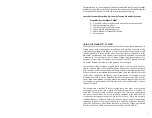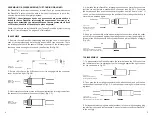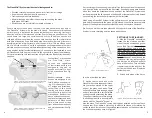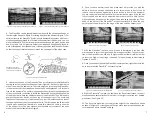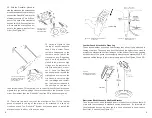
4. The PianoMic
™
can be placed inside the piano with the microphone heads ei-
ther facing the dampers
(Figure 6)
or facing away from the dampers (Figure 7). For
optimum results, the PianoMic
™
System should be placed in the piano with the mi-
crophone heads positioned two to three inches away from the dampers. How you
place the PianoMic
™
System in the piano will depend upon the piano, its size and
how it is made. This will govern whether the microphone heads can be faced to-
ward or faced away from the dampers. It is best to position the PianoMic
™
System
so that the support bracket does not rest on the curved part of the piano case.
5. Notice that one end of the PianoMic
™
has a multi-connector shielded cable
coming out of the tube below the support arm
(Figure 8)
. It doesn’t matter which
side of the piano the cable exits. The main objective is to place the PianoMic
™
in the piano so that the microphone heads can be easily placed 2 to 3 inches in
front of the dampers. The cable is long enough to easily reach the opposite side
of the piano should you decide to locate the electronics box on the opposite side
of the piano from where the cable comes out of the PianoMic
™
. You will need to
position the cable so it does not lie on top of the support arm. The combined
thickness of the support arm with the cable on top if it would exceed the size of
the opening between the piano case and the lid. Therefore when the lid is closed
it would pinch and deform the cable. To avoid this, place the cable to one side
of the support arm. You may also position the cable so it comes out the open
area of the piano as illustrated in Figure 8.
6
Figure 8. Positioning the PianoMic Cable
PianoMic multi-conductor
shielded cable that connects to
electronics box via 5-pin XLR.
Figure 6. Facing the Mic Heads Towards the Dampers
Figure 7. Facing the Mic Heads Away From the Dampers
6. Once you have determined which placement will provide you with the
ability to have the microphone heads two to three inches in front of the ity
to have the microphone heads two to three inches in front of the dampers,
you are ready to place the PianoMic
™
System inside the piano. With the bar
fully extended and the clutch adjusted where there is still a little friction,
place the support bracket on the edge of the piano case opposite you. Then
push on the bar until the PianoMic
™
is the correct length to allow the sup-
port bracket to easily rest on the edge of the piano case nearest to you.
7. With the PianoMic
™
in place, you will need to determine if you want the
microphones to favor the high strings, low strings or neither. The center sec-
tion of the PianoMic
™
can slide up to eight inches in either direction in order
to favor the high or low strings, if desired. This positioning is illustrated in
Figures 9 and 10.
8. Once you have positioned the PianoMic
™
center section, tighten both clutch-
es to insure that the PianoMic
™
bar stays in place.
9. With the PianoMic
™
in place, you can move the flex arms attached to the mi-
crophone heads several inches to the left or to the right to achieve your desired
placement
(See Figure 11).
10. The flex arms also allow you to adjust the height of the microphone heads
as shown in Figure 12. It is suggested that you place the microphone heads two
to three inches above the piano strings.
7
Figure 9. Favoring the High Strings
Figure 10. Favoring the Low Strings
Figure 11. Adjustable flex arms for the Microphones
Figure 12. Adjusting the Microphone Height
Summary of Contents for PM40T
Page 8: ...Notes 12...


